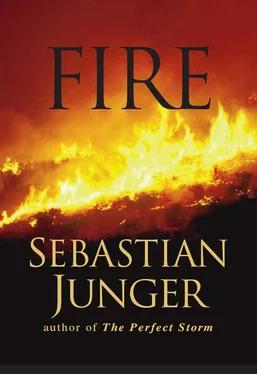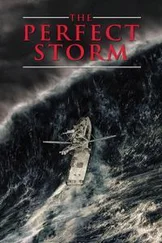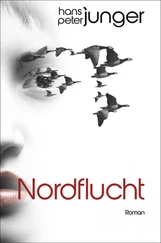In the end five million acres were burned in 1910, and flame-killed trees provided fuel for reburn cycles that lasted well into the 1930s. Reburns spread into healthy timber and ultimately redoubled the acreage that was lost. Faced with the possibility of a lumber shortage and consequently under tremendous political pressure, the Forest Service finally gave fire suppression top priority. Money was appropriated by Congress, crews were organized, lookout towers were built, timber companies constructed access roads into the mountains, telephones began to replace runners and mounted messengers. Fire fighting had finally entered, as one historian said, its heroic age.
The new approach showed results, but the West was still vulnerable to large-scale conflagration. The next big round of tactical changes came, not surprisingly, after the next big catastrophe, the Tillamook burn in 1933 that laid waste to half a billion board feet of Douglas fir in Oregon. Like the Big Blowup, Tillamook was merely the flagship of an armada of fires—Matilija, Selway, and others—that pummeled the West for three years. They prompted the Forest Service to adopt its famous 10:00 A.M. control policy, which meant that all fires were to be brought under control, if possible, by 10:00 the next morning. The policy would have been complete hubris were it not for a growing arsenal of fire-fighting tools: bulldozers that did the work of fifty men; airplanes that dropped thousands of gallons of retardant at a time; smoke jumpers who hit remote fires that would have taken men days to reach by foot. The idea was to get into the mountains fast and control the fires while they were still small; if a fire got away from the initial attack crews, thousands of lesser-trained men could be brought in to take over. As a tactic it made sense; as a public relations ploy it was unparalleled. Funding from Washington became effectively unlimited and remains so to this day.
As weather forecasting and communications improved, the loss of life declined, but mass tragedies still occurred. In 1937 a Civilian Conservation Corps crew of fourteen on the Blackwater fire were trapped between a spot fire and the main fire; they decided to turn and fight the spot rather than run, and they all died. In 1943 eleven marines died and seventy-two were injured when Santa Ana winds changed abruptly on the Hauser Creek fire in Southern California. In 1949 thirteen smoke jumpers and another man died in knee-high grass during a blowup on the Mann Gulch fire in Montana. In 1956 eleven convicts died on the Inaja fire in Southern California, and ten years later a hotshot crew lost twelve men in nearly identical circumstances on the Loop fire in the Angeles National Forest. A spot fire started at the bottom of a canyon, blew up unexpectedly, and ran twenty-two hundred feet of the canyon in less than a minute. That’s twenty-five miles an hour. The crew didn’t have a chance.
By the 1970s fire crews had portable fire shelters and Nomex clothing and could theoretically survive some burnovers. Fire shelters start to disintegrate at around six hundred degrees, though, and a fire run in heavy timber can hit temperatures three times that high. The only thing that will save a crew in the face of such an inferno is to get out of the way before it hits, and to that end researchers at the Intermountain Fire Science Laboratory in Missoula, Montana, have developed mathematical models that predict—given certain fuel conditions, terrain type, and meteorological conditions—what a fire will do. These models have been programmed into computers and can be used in conjunction with satellite data to project fire growth on any fire anywhere in the United States. The incident command team on a fire can punch its location into a computer, along with topographical and meteorological information, and receive very specific information about likely fire behavior the following day: which canyons will burn out; which ridgelines will hold.
Still, no amount of computing power can predict exactly what a fire will do.
“Nothing we’re doing today is more important than a human life,” one incident commander said at a 6:00 A.M. briefing.
That sentence—more than fire behavior models, lightweight fire shelters, or advanced meteorology—explains why people no longer die in the terrible numbers they used to on wildfires in the United States.
In the middle of the afternoon we moved down off the ridgetops toward H-6. Helicopters were to lift us and the three crews down to the fire camp for the night. I was in no hurry to leave the mountains, but the Union, Negrito, and Smokey Bear crews were being replaced by type two outfits that hadn’t spent the last two nights spiked out. We clustered around the helispot and then piled onto the helicopters with our line packs and were shuttled back to camp.
That night I heard that a fire had just leaped the huge Salmon River Canyon up by McCall; a fire had started north of the river and a backburn had been set by dropping flaming Ping-Pong balls from a helicopter. (The Ping-Pong balls are filled with potassium permanganate and ignited by antifreeze. A needle injects the antifreeze at the moment of release and they ignite after thirty seconds, usually after they hit the ground. The helicopter pilot had circled to check his work, and one of the balls had accidentally released over the south side of the river. That was all it took. Within hours the new fire was fifty acres in size and crowning through heavy timber.
I drove up to McCall the next morning to see if I could get on the fire, but by then it was so far out of control that no one was allowed near it. Crews were cutting indirect line miles ahead of the fire and cold-trailing their way southward from the river, but that was it. The town of Riggins was filled with smoke; there was a mushroom cloud of smoke pumping out of the canyon; the airfield at McCall was crammed with reserve helicopters. But I wanted to see real flame. I slept on a sandbar along the North Folk of the Salmon River and drove back to Boise the next day. There was another fire north of town, I was told. It was racing through the dead-brown hills, and hotshots were getting pulled off Foothills to deal with it. It was bad, and it was moving fast.
There’s a little river that runs through Boise, and from the cafés that line the river walk, I could look up and watch the mountains burn. A big head of smoke was pumping out of the hills to the north, and retardant-streaked air tankers were making nonstop runs to and from the tanker base at the Boise airport, south of town. According to dispatch, bulldozers were trying to save a subdivision off Highway 21, wind-driven flames were racing through the terrifically dry sagebrush and cheatgrass around Lucky Peak Reservoir, and fifty crews left over from the Foothills fire were waiting to go in. I picked up a pass for the roadblock and headed north up Highway 21, toward the smoke.
Manpower was so short that the roadblock was guarded by a middle-aged couple in lawn chairs. I showed them my letter, and they waved me through. Soon I was alone on the dirt road that led into the burn zone. A line of flame hung like a necklace along the parched flanks of the hills. Smoke had turned the sunset blood-red. After three or four miles there was a hand-written cardboard sign that read: AREA CLEARED @ 19:30 HOURS 9/2—U.S.F.S. Just beyond that was the fire. It had reached the road and was swirling around a utility line that continued on up into the hills. I stopped the car and got out, completely alone with the fire and the mountains and the huge dead sky. Ten-foot tongues of flame licked the guardrails and shot into the sky. The vegetation died loudly, as if in pain, popping and exploding in the thickening dusk.
I took a few photographs and then went back to my car. The fire was about to jump the road. It would eventually move up into some timber and end up torching over thirteen thousand acres. A house would burn down. The beautiful Leonard ranch would be saved—barely—by ground and dozer crews backed up by massive air attack. It was called the Dunnigan Creek fire. It was one of roughly one hundred thousand wildfires during the summer of 1992, and if you ask a hotshot if he’s ever heard of it, chances are he’ll say no. Rain put it out after a couple of days.
Читать дальше












